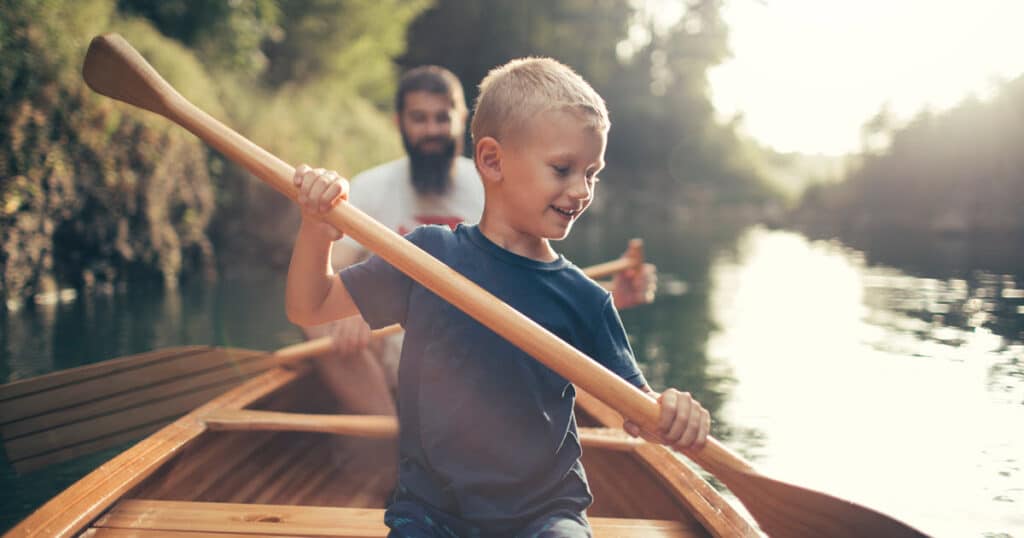A low-impact physical activity that provides a relaxing day on the water in the great outdoors, canoeing has been a popular way to travel rivers, lakes, and streams for many years. But is canoeing hard to learn if you’ve never tried before? If you’d like to try canoeing, but have never been before it’s natural to worry that it’s too difficult physically. You may also be concerned about the safety of canoeing as a novice.
In today’s article I’ll address these concerns and explain why canoeing is not as difficult as you might think. I’ll also share some tips for success as a first-time canoer.
So, Is Canoeing Difficult?
In short, canoeing isn’t hard. Even if you’ve never done any kind of paddling before, it shouldn’t take long to learn to correctly paddle a canoe. And while it’s good exercise, most people will be able to paddle a canoe (even if you aren’t in the best shape).
Of course, like every other activity, it will take time to reach an advanced level. But if you just want to canoe for relaxation or a casual sport, learning it shouldn’t be too challenging.
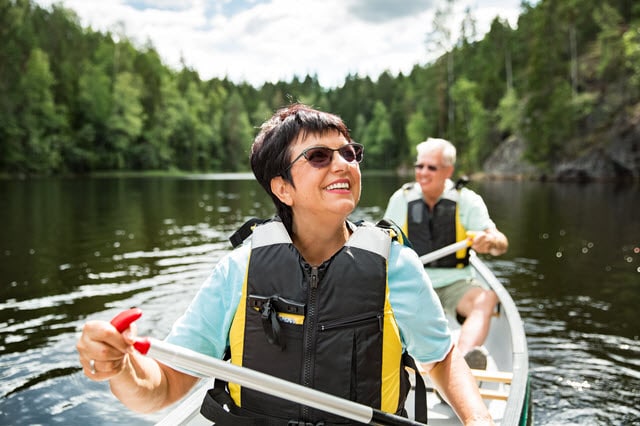
An exception, however, is solo canoeing. If you want to take a canoe out on the water by yourself, you’ll find learning to canoe presents a bigger challenge.
That is because if you’re canoeing with another person in the canoe, you have their help and muscle power in propelling the watercraft forward through paddling. Of course, you must know how to swim before considering canoeing. And in most states wearing a life jacket is the law (and it’s common sense everywhere).
After all, if you swamp your canoe and fall into the water, that is a dangerous (and potentially deadly) situation. Overall, most people with decent swimming skills find they are able to learn canoeing relatively quickly and easily.
Let’s learn more about canoeing below.
Is Learning Tandem Canoeing Hard?
Most of the time, canoers take part in tandem canoeing. This means that they are canoeing with one other person in the boat who is helping them paddle.

Most canoes have two seats (unless you add a drop-in seat, or purchase a solo canoe that only has a single seat toward the center of the vessel)
If you want to learn how to tandem canoe, you can usually do so within about half an hour if you are going to sit at the front of the canoe. If you want to sit at the back, it will take a bit longer to master, usually up to a couple of hours. This is because the person in the stern (rear) of the canoe is responsible for steering the boat, so there are a few more strokes to practice and get the hang of.
If it’s your first time canoeing, I recommend going with a friend who is an experienced paddler, and sitting in the front of the boat. This way you’ll have more fun and get some practice and confidence while knowing it’ll be easy to get back to shore.
Is Learning Solo Canoeing Hard?
Learning how to canoe solo is a bit more difficult than learning how to canoe with others. You need to use different and more challenging techniques for paddling when you’re in a canoe by yourself.
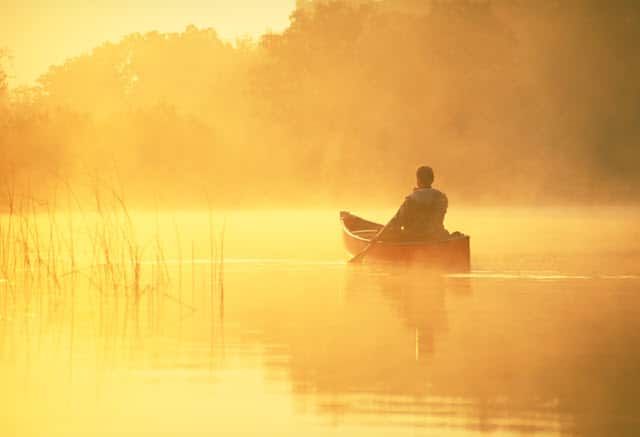
If you want to learn solo canoeing, you will usually have to devote a minimum of one hour, and probably two, to the task, and I don’t recommend first-time paddlers try in rough water. Choose a calm day and stay near the shore to practice.
How to Start Learning How to Canoe
Of course, before you start learning how to canoe, you’ve got to know how to get in your watercraft. Make sure that you have a canoe paddle that is sized appropriately. And before that, you should understand the different parts of a canoe and how they function as you get into the canoe and make it move through the water.
The front of your canoe is called the bow, while the back is called the stern. As a beginner, you should start off with tandem canoeing (ideally with someone who has some experience), and wait until you’re a bit more advanced before you try to do solo canoeing.
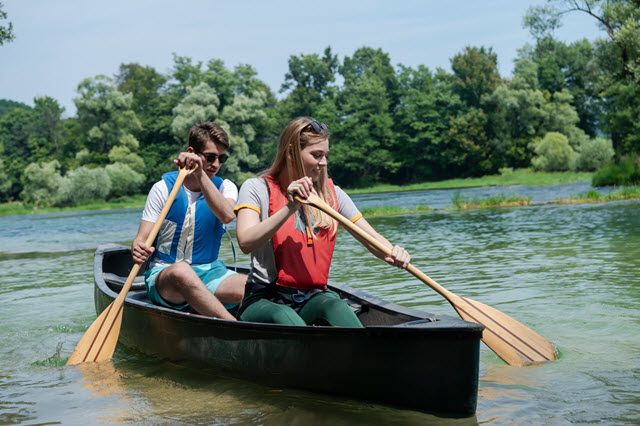
You and your canoeing partner need to decide where each of you will sit in the boat.
Sitting in the Stern of a Canoe
The person sitting at the back of the boat (the stern) will be responsible for most of the steering. It’s best if your canoeing partner has some experience with the activity, so they can help guide you.
Sitting in the Bow of a Canoe
The person seated in the bow is primarily tasked with paddling to provide the boat with power. You don’t need to be especially strong to do this, simply focus on paddling at a steady, even pace to keep the boat moving while your partner steers and keeps the canoe moving in the right direction.
Balancing Weight in a Canoe
Another important rule is to ensure that you know your own weight and that of your canoeing partner. This way you can ensure that the heavier person is in the stern (rear) of the canoe. This allows the bow of the canoe to ride higher, and you’ll have an easier time paddling your boat.
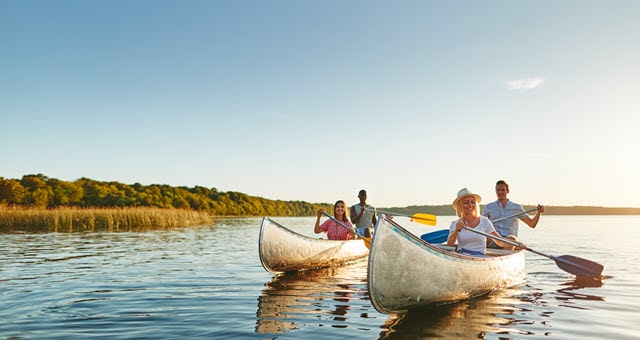
Balancing Weight in a Canoe with a Small Child
Sometimes, if you’re especially large and paddling with a child, having the adult seated in the rear of the canoe is untenable because the bow will be lifted quite far out of the water. In this case (if it’s comfortable for the child), I recommend reversing the craft. The adult will sit in the front seat, facing backwards, so his or her weight is more centered in the craft. The child will sit in the rear seat, facing the rear.
There won’t be much leg-room for the child, but if it’s a younger kid this will probably still be fine, and it will solve your canoe’s balance issue.
When you’re more experienced, you won’t have to worry about this. As a beginner, however, you will find canoeing very difficult if you try to put the heavier person at the front and paddle in that direction.
If you want to try solo canoeing in a tandem canoe, you should sit further forward in the canoe than you would otherwise. At the same time, however, your goal is to keep your bodyweight near the canoe’s middle area. This helps to stop the bow being negatively affected and thrown off course by wind. This is another time when using the front seat (facing backward) will be advantageous. It keeps your weight toward the center of the canoe and helps with balance. Kneeling in the center of the canoe as you paddle is another option.
Most canoes are symmetrical. This gives you the option of turning the boat and paddling it in either direction. This simple trick can help you to keep the weight balanced as I’ve discussed above.
Getting Into a Canoe
This is one of the most challenging parts of getting started with canoeing. It sounds simple, but remember that your canoe is on the water and movement will change how it is balanced.
Once you get some practice with the process of getting into a canoe, however, it will become easy. Eventually, you’ll do it without a second thought.
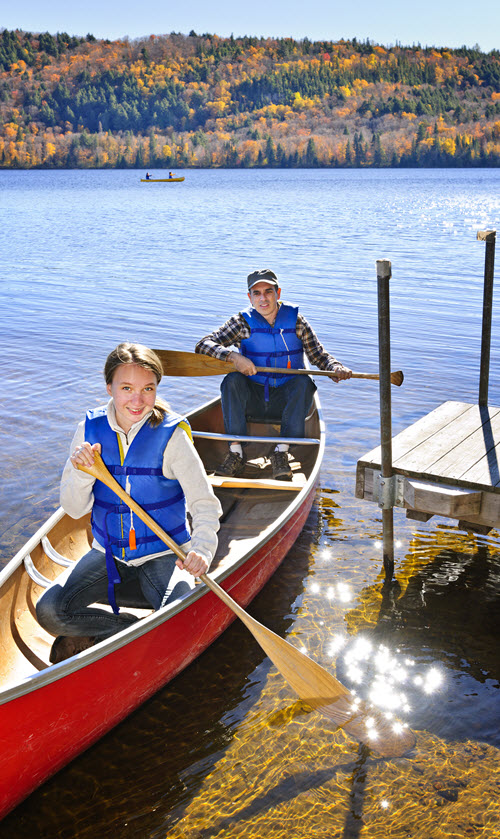
One reason it’s initially difficult to keep your balance and the canoe’s balance when getting into the boat is the reality that you have a high center of gravity during this process.
This affects your boat’s balance. Once you successfully get into the canoe and sit down, however, that problem should be solved.
If you’re a canoe beginner, make sure you have a boating partner with you when you out on the water. Ideally, this person will be more experienced with you when it comes to canoeing.
Ask the other person to stay in the canoe and sit in the stern area. They can be holding on to keep the canoe stable as you make your way inside the cockpit.
Getting Out of a Canoe
In the excitement of going canoeing for the first time, you may not have thought of getting out of the canoe at the end of your trip. But this is more challenging than you probably imagine. Again, this is because of how you standing up throws off the balance of the boat.
Like the process of getting into the canoe, getting out of the canoe without falling over (and potentially into the water) is much easier if you have someone there with you to stabilize the boat.
What are the Physical Challenges of Canoeing?
The main physical challenges of canoeing center on the shoulders, arms, and wrists. This is because these areas of the body are put to use as you paddle. You’ll be relying on your muscles and joints to move the boat through the water.
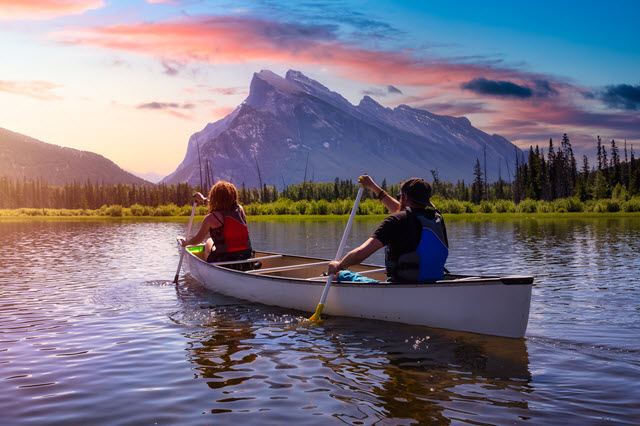
Overall, however, if you’re healthy and in good shape overall, canoeing is a low impact activity. As we all know, low impact activities are a useful way of staying in shape for people who cannot take part in high impact physical activities without injury.
Are There Risks Involved in Canoeing?
Like any other sport, there are some potential risks involved in canoeing. Of course, the risk in this sport isn’t as great as many others. And the exact risk you face depends on your characteristics as an individual.
Of course, you must be able to swim if you want to engage in any kind of water sports. That is because falling into the water is a real risk if you go into a boat. This is especially true as a beginner. And if you fall into the water and cannot swim, you might drown.
Getting Your Canoe to the Water
Getting your canoe to the water is often the most challenging part of the activity. It’s important to safely and securely strap your canoe to your vehicle.You need to have some knowledge about how to do this without damaging your car, your canoe, or hurting yourself.
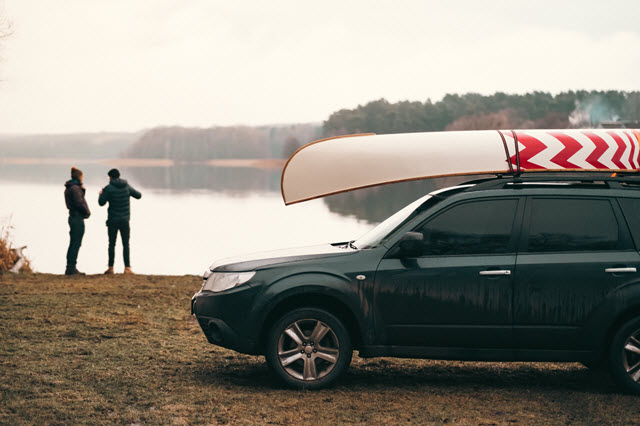
That is why many canoers turn to specialized types of equipment and tools for this task.
If you’re serious about getting started with canoeing and you know you’ll have to transport your watercraft to a river or lake to enjoy it, look into investing in some of this equipment.
At a minimum you’ll need some rugged roof straps, and foam blocks (if you don’t have a roof rack on your vehicle). This kit or a similar one from Amazon will get the job done for most people.
Final Thoughts About the Difficulty of Canoeing
Of the many different types of self-propelled boating, canoeing may be the easiest to get the hang of. This is especially true if you go with someone who has some experience on your first trip.
So, what do you think? Are you ready to get started with canoeing? If you wanted to canoe before and felt intimidated, now you know it’s an activity most people can enjoy. As long as you can swim, this should be a safe activity for you when enjoying the great outdoors.
Just practice in calm waters and near the shore your first time out on the water.

